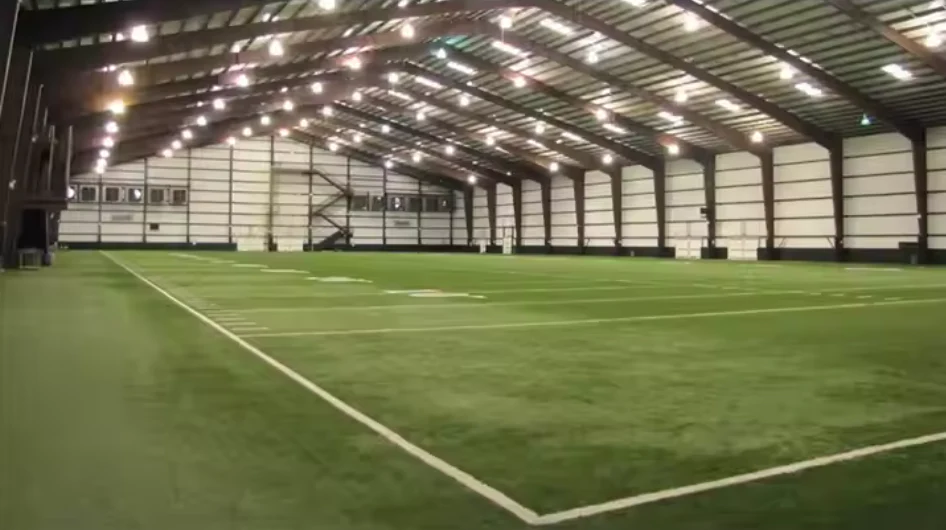When you watch a baseball player take swing after swing in a controlled environment, you may not think too much about what makes that practice possible. But behind every safe and effective training session, there’s a critical piece of equipment working quietly in the background: the batting cage net.
Without a strong and durable batting cage net, batting cages would simply not exist in the way we know them. They protect players, coaches, and bystanders, while also creating the perfect space for repetition and focused practice. For anyone serious about baseball, whether it’s a young athlete learning fundamentals or a professional fine-tuning mechanics, the net is one of the most important pieces of training infrastructure.
In this article, we’ll explore how batting cage nets contribute to player development. We’ll look at their role in safety, repetition, skill building, and how they integrate with other equipment like batting cage turf and complete outdoor batting cages. We’ll also cover the materials, maintenance, and selection process for nets, as well as the long-term impact they have on athletes’ progress.
Why Batting Cage Nets Are Essential
At its core, the batting cage net serves two vital purposes: safety and repetition. Baseball is a sport of precision, and hitters need hundreds of swings per week to build rhythm and muscle memory. Practicing in an open field isn’t practical, especially when stray balls can cause damage or injury. The net allows for intense, focused training in a compact space, making it possible for players to repeat movements without constant interruptions.
Safety is equally important. Baseballs hit off a bat can travel at speeds exceeding 100 mph. Without a protective net, those balls can become dangerous projectiles. A well-built batting cage net absorbs the impact, ensuring both the batter and anyone nearby remain safe. This controlled environment is what makes year-round training feasible.
The Connection Between Nets and Muscle Memory
One of the biggest advantages of practicing inside a batting cage is repetition. Athletes can take hundreds of swings in a single session without stopping to retrieve balls. Over time, this repetition leads to muscle memory — the subconscious ability to repeat a movement accurately and efficiently.
The batting cage net plays an unseen but vital role here. By creating a contained environment, it allows hitters to focus purely on mechanics: stance, grip, bat speed, timing, and follow-through. The more swings a player can take in this controlled space, the stronger their muscle memory becomes. That consistency is what translates into improved performance during actual games.
Batting Cage Nets and Player Confidence
Confidence is as critical as skill in baseball. A hitter who feels uncertain or distracted is less likely to succeed. Practicing in a secure cage with a strong batting cage net gives players peace of mind. They know the balls will be contained, and they don’t have to worry about errant hits causing accidents.
This mental assurance allows players to concentrate on mechanics rather than safety concerns. Over time, that confidence carries over to the field, where players can swing freely knowing their practice has prepared them well.
Integration with Other Training Tools
A batting cage doesn’t exist in isolation. Its effectiveness comes from how it integrates with other equipment. For example, the flooring beneath the net often uses batting cage turf, which provides a durable, non-slip surface for players. Turf reduces wear on players’ cleats, absorbs impact, and creates a more realistic playing experience compared to concrete or dirt.
Similarly, complete outdoor batting cages use heavy-duty nets designed to withstand weather conditions. In these setups, the net is not just an accessory but the centerpiece of the structure. Without it, the cage wouldn’t function. Together with hardware, poles, and turf, the net forms the core training environment for athletes.
Materials and Construction of Batting Cage Nets
Not all nets are created equal. The effectiveness of a batting cage net depends heavily on the material and construction.
-
Nylon Nets: Known for strength and durability, nylon nets are commonly used in professional and commercial facilities. They resist high-speed impacts but can degrade under UV exposure if not treated.
-
Polyethylene Nets: These nets are more affordable and naturally resistant to moisture, making them ideal for outdoor use. They may not be as strong as nylon but are practical for many teams and individuals.
-
Twine Thickness: The gauge or thickness of the twine determines how well the net holds up under repeated impact. Thicker twine increases durability but also adds cost.
-
Knotless vs. Knotted Construction: Knotless nets offer a smoother surface, reducing wear on balls, while knotted nets may provide added durability at stress points.
Choosing the right batting cage net depends on intended use — whether it’s for youth practice, professional training, or backyard setups.
The Role of Nets in Hitting Drills
Drills are at the heart of player development, and the batting cage net makes many of these possible. Coaches often design hitting sessions that involve hundreds of repetitions in a short period. For example:
-
Soft Toss Drills: A coach or teammate tosses balls underhand while the hitter focuses on mechanics.
-
Tee Work: Players work on stance, swing path, and contact point without worrying about chasing balls.
-
Live Pitching Practice: The net contains balls from pitchers, allowing hitters to adjust to game-like speeds.
Without a cage net, these drills would require constant ball retrieval and expose players to higher risks. The net, therefore, enables efficiency in training while allowing coaches to focus on teaching instead of logistics.
Nets and Year-Round Training
Player development doesn’t stop when the season ends. In colder regions, outdoor fields may be unusable for months. That’s where indoor cages with durable batting cage nets come in. These setups allow players to train year-round, ensuring they don’t lose rhythm or conditioning.
Indoor nets are usually paired with artificial lighting, turf flooring, and controlled environments to simulate real playing conditions. For young athletes especially, the ability to train consistently, regardless of weather, is a major advantage in long-term development.
Net Longevity and Maintenance
For players and organizations, nets represent an investment. To ensure that a batting cage net lasts, proper maintenance is crucial. Regular inspection for tears, fraying, or weak points helps extend its life. If used outdoors, nets should be UV-treated to withstand sun exposure.
Cleaning also matters. Dirt, dust, and moisture can degrade net fibers over time. Simple practices like occasional rinsing and proper drying can add years to a net’s usability. Storing nets properly during off-seasons can also protect them from unnecessary wear.
How Nets Support Different Skill Levels
From Little League to Major League Baseball, players at every level rely on cage nets. For beginners, nets create a safe environment to learn without fear of breaking windows or injuring others. For advanced players, nets provide the repetition and focus needed to refine mechanics.
At higher levels, nets are often paired with advanced technology, like pitching machines or swing analyzers. The net still plays the same role: containing the practice space and allowing drills to happen smoothly.
The Bigger Picture: Nets in Player Development
When we talk about player development, we usually think about coaching, drills, or physical conditioning. But infrastructure is just as critical. Without safe and efficient training environments, players cannot get the repetition needed to improve. The batting cage net may not seem glamorous, but it’s a foundational part of this infrastructure.
It creates the space for focus, safety, and confidence. It enables year-round training, supports different skill levels, and integrates seamlessly with other equipment like turf and hardware. In many ways, the net is the silent partner in every hitter’s journey.
Conclusion
The journey from a beginner swinging awkwardly at pitches to a confident hitter who can perform under pressure is long and demanding. Repetition, safety, confidence, and structured training are all essential — and none of these would be possible without the batting cage net.
By providing a safe, consistent, and efficient training space, nets play a direct role in building the muscle memory, accuracy, and confidence that define great hitters. When paired with quality batting cage turf and complete outdoor batting cages, they form the backbone of effective baseball training environments.
For coaches, parents, and players, investing in a high-quality net isn’t just about equipment — it’s about player development, safety, and the future of the game itself.
FAQs
1. How long does a batting cage net typically last?
The lifespan depends on material, usage, and maintenance. Nylon nets can last 5–8 years with proper care, while polyethylene nets may last 3–5 years. Indoor use often extends durability compared to outdoor exposure.
2. Can the same batting cage net be used for baseball and softball?
Yes, most nets are designed to handle both sports. However, net size and thickness should be considered if the cage will see heavy or professional-level use.
3. What is the best way to maintain a batting cage net?
Regular inspection, cleaning, and proper storage are key. Outdoor nets should be UV-treated and stored indoors during harsh weather. Indoor nets should be checked for wear at high-impact areas.
4. Should I choose nylon or polyethylene for my batting cage net?
Nylon is stronger and better for heavy use, making it ideal for professional or high-traffic cages. Polyethylene is more affordable and naturally moisture-resistant, making it suitable for backyard or budget-conscious setups.



